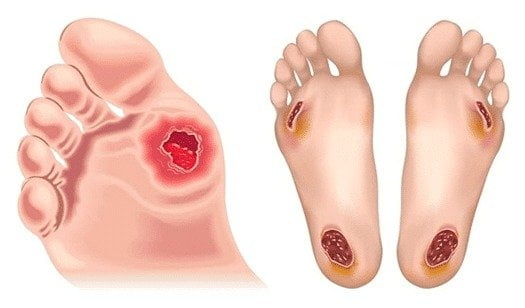If you have diabetes, here’s a way to keep standing on your own two feet: check them every day—even if they feel fine—and see your doctor if you have a cut or blister that won’t heal.
There’s a lot to manage if you have diabetes: checking your blood sugar, making healthy food choices, finding time to be active, taking medicines, going to doctor’s appointments. With all that, your feet might be the last thing on your mind. But daily care & good control of your sugars are the best ways to prevent diabetic foot problems & complications.
About half of all people with diabetes have some kind of nerve damage or neuropathy. You can have nerve damage in any part of your body, but nerves in your feet and legs are most often affected. Nerve damage can cause you to lose feeling in your feet.
Some people with nerve damage have numbness, tingling, or pain, but others have no symptoms. Nerve damage can also lower your ability to feel pain, heat, or cold.
Living without pain sounds pretty good, but it comes at a high cost. Pain is the body’s way of telling you something’s wrong so you can take care of yourself. If you don’t feel pain in your feet, you may not notice a cut, blister, sore, or other problem.
Small problems can become serious if they aren’t treated early. It is important to attend regular podiatry appointments and wear supportive shoes, or fitted orthotics, to reduce diabetic foot problems.
Finding a supportive podiatrist, that you like working with, is an important part of your healthcare journey. We are lucky on the Sunshine Coast that we have many local skilled podiatrists to help you. Find a local podiatrist link
Diabetics that are at higher risk of nerve damage/neuropathy:
- Blood sugar levels that are hard to manage
- Having diabetes for a long time, especially if your blood sugar is often higher than your target levels
- Being overweight
- Being older than 40 years
- Having high blood pressure
- Having high cholesterol
Nerve damage, along with poor blood flow or peripheral arterial disease—another diabetes complication—puts you at risk for developing a foot ulcer (a sore or wound) that could get infected and not heal well. It is best to get this looked at early; a diabetic foot infection or sepsis can spread quickly and make you very very unwell.
Dr O’Donnell is skilled in diabetic foot problem assessment, wound care, lower limb angioplasty & stent procedures & lower limb bypass operations. If you have reduced blood flow known as peripheral arterial disease, to your ulcer or foot, you may require urgent vascular surgery.
In the worst case scenario, if an infection doesn’t get better with treatment, your toe, foot, or part of your leg may need to be amputated (removed by surgery) to prevent the infection from spreading and to save your life.
When you check your feet every day, you can catch problems early and get them treated right away. The good news is that early treatment greatly reduces your risk of toe or lower limb amputation.
Keep your blood sugar in your target range as much as possible. This is one of the most important things you can do to prevent nerve damage or stop it from getting worse.
Other good diabetes management habits can help, too:
- Don’t smoke. Smoking reduces blood flow to the feet.
- Follow a healthy eating plan, including eating more fruits and vegetables and less sugar and salt.
- Get physically active—10 to 20 minutes a day is better than an hour once a week.
- Take medicines as prescribed by your GP/Endocrinologist/Vascular surgeon
Diabetic feet self care tips:
- Check your feet every day for cuts, redness, swelling, sores, blisters, corns, calluses, or any other change to the skin or nails. Use a mirror if you can’t see the bottom of your feet, or ask a family member to help.
- Wash your feet every day in lukewarm (not hot) water. Don’t soak your feet for prolonged periods of time. Dry your feet completely and apply lotion to the top and bottom—but not between your toes, which could lead to infection.
- Never go barefoot. Always wear shoes and socks or slippers, even inside, to avoid injury. Check that there aren’t any pebbles or other objects inside your shoes and that the lining is smooth.
- Wear shoes that fit well. For the best fit, try on new shoes at the end of the day when your feet tend to be largest. Break in your new shoes slowly—wear them for an hour or two a day at first until they’re completely comfortable. Always wear socks with your shoes.
- Trim your toenails straight across and gently smooth any sharp edges with a nail file. Have your foot doctor (podiatrist) trim your toenails if you can’t see or reach your feet.
- Don’t remove corns or calluses yourself, and especially don’t use over-the-counter products to remove them—they could burn your skin.
- Get your feet checked at every health care visit. Also, visit your foot doctor every year (more often if you have nerve damage) for a complete exam, which will include checking for feeling and blood flow in your feet.
- Keep the blood flowing. Put your feet up when you’re sitting, and wiggle your toes for a few minutes several times throughout the day.
- Choose feet-friendly activities like walking, riding a bike, or swimming
Diabetes Australia Preventing Diabetic Foot Complications
Foot Forward Patient Education Program


